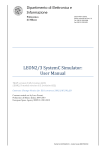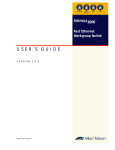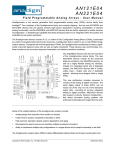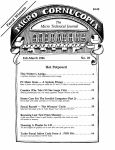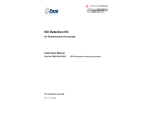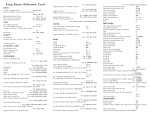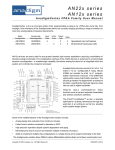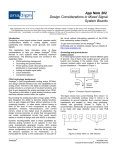Download onproject Programmable analog
Transcript
hands-onproject By Joshua Israelsohn, Technical Editor Pour your own M ost industries have their philosophical tugs of war, and if only for sheer enter- tainment value, perhaps it is fortunate that ours has more than its share. Throughout our industry’s history and at nearly every turn, engineers and technologists with strong convictions have alternatively touted the superiority of tubes or transistors, discrete or integrated circuits, reduced or complex processor instruction sets, Harvard or von Neumann processor architectures, CMOS or bipolar circuits, systems on chips or funcAt a glance..........................39 tional segmentation, and certainly not least among these topics, though broad they Finding the baseline ........42 may be, analog or digital circuits. Though For more information ......46 the tensions have fueled many a lively conference panel discussion, taken by themselves, these little battles often suffer the same conceptual defect: They argue an implementation technology ahead of the goal. Such discussions are not, however, mere displays of opposing chauvinisms entirely devoid of value. They help point out areas in which technologies overlap and in which engineers must choose between contending approaches. The choices are often tangled with trade-offs between competing criteria and technologies that enjoy at best orthogonal advantages. Prioritizing the selection P R O G R A M M A B L E A N A L O G POURING ANALOG-CIRCUIT DESCRIPTIONS THROUGH AN INTERFACE SOUNDS LIKE A VERSATILE WAY TO FORM FUNCTIONAL BLOCKS. BUT BEFORE I HANG UP MY SOLDERING IRON, I WANTED TO KNOW HOW WELL THEY WORK IN PRACTICE. 38 edn | June 12, 2003 www.edn.com AT A GLANCE criteria, evaluating the relative merits of design alternatives, balancing the trade-offs, and optimizing a design for a set of goals are properly left as exercises each designer must work through in the context of an individual project, guarding all the while against confusing the most familiar approach with the best one. And, as if that weren’t enough, the design world is rarely homogeneous; more often than not it’s a matter of one and the other, not one or the other. At minimum, for example, OEMs involved in analog design commonly use shards of control logic in the form of inexpensive microcontrollers or— thanks to mixed-signal integration—small cores or even homebrewed state-machines. More typically, analog circuits serve as the physical interfaces for predominantly digital systems (Reference 1). Rather than representing opposing disciplines, as they are so often miscast, the crafts of analog and digital design have acted synergistically for decades; witness the great success of mixed-signal ASSPs (application-specific standard products). But despite significant strides in mixedsignal design, the analog discipline has not, by and large, evolved to include devices whose functions, like digital devices, are either statically or sequentially determined by programming, not by wiring. Analog-IC manufacturers have used the term “programmable” in a variety of ways, mostly in place of “adjustable.” In such cases, the term is often adjacent to a qualifier, such as “pin” or “resistor.” Thus, programmable-gain amplifiers allow you to set the closed-loop gain with a fixed resistor, continuously variable resistor, or a network of fixed resistors and switches. A number of analog-IC manufacturers sell op amps that are bias-current-programmable with respect to gain-bandwidth product, slew rate, and power dissipation. Others offer digitally programmable potentiometers and other R-DAC-based cells whose behaviors vary by a digital word acting most often on a single parameter. These fixed Illustration by Rob Magiera functions, though indeed useful, do not offer the sort of functional programmability you think of when you consider digital constructs any more advanced than simple combinatorial logic. www.edn.com 컄 The good: You can be up and running in no time. The interface is suitably intuitive, and the development tool includes a rudimentary simulator that can speed circuit design. The parametric ranges for most cells are impressive, and reprogramming either individual parameters or the entire topology on the fly is quick and easy. 컄 The bad: There is no apparent way to simulate the product on or to export simulation data to a standard Spice tool. There is also no way to include components external to the FPAA in its simulation. This situation is similar to that which exists in many of the more sophisticated power ICs and ASSPs whose manufacturers provide limited but useful design-support software. 컄 The ugly: Not much, really. The antialiasing filter on the FPAA’s input cells can increase distortion when set near the low-frequency extreme of its tuning range, particularly with large amplitude signals. Don’t expect 16-bit noise performance from a 12- to 14-bit product. Be careful to read the evaluation board’s manual before you apply power to the board. June 12, 2003 | edn 39 hands-onproject Programmable analog Only a few companies, most notably Zetex, Lattice Semiconductor, and Anadigm, offer topological programmability within analog ICs (references 2 and 3). These devices provide programmable connectivity as well as parametric control of analog-signal-processing resources, and their manufacturers often compare them with FPGAs; indeed, Anadigm refers to its device as an FPAA (field-programmable analog array). board’s DB-9 connector. The onboard 16-MHz oscillator provides the FPAA’s analog clock. A freestanding mode makes use of either an SPI EEPROM, such as Atmel’s AT25080 8-kbit device, or an FPGA EEPROM, such as Atmel’s AT17C65 65-kbit chip. In this mode, the onboard clock drives the configuration process during the turn-on sequence and provides the timebase for the analog clock. If yours is an embedded application development, you can directly drive the digital signals through the ⫻5.375 The AN220D04, which measures 4.5⫻ DIO (digital-I/O) ribbon connector. Figure 1 JUMP(ER)ING IN in., includes a 1.9-sq-in. breadboard area Though the current software version Though topologically program- and a host of jumpers, connectors, and pin headers, does not support USB, the board’s USBmable analog ICs are relatively im- forming a flexible development environment that’s easy capable microcontroller, a Microchip mature from a market-acceptance to use once you’ve spent a few minutes with the map. PIC16C745, is wired to an unpopulatperspective, their manufacturers ed connector site. Should Anadigm are demonstrating an increasingly so- Two chip applications route their analog choose to include USB support in a future phisticated understanding of the market signals through the daughterboard only, software revision, you will need only to needs. The evaluation/development bypassing the FPAA position on the main solder to a connector and plug in. package from Anadigm that I recently board. The evaluation board also proThough most of us are in the habit of testdrove is a case in point. The package, vides an extension connector for cascad- hooking up a new piece of gear while the which supports Anadigm’s AN220E04 ing multiple AN220D04 boards. documentation is still in the shrink wrap, FPAA, comes with an evaluation board, You can set up the board’s analog in- this board offers so many options that I AnadigmDesigner2 software, a serial ca- puts and outputs independently for ei- recommend perusing the user manual ble, and documentation. Among the doc- ther balanced or unbalanced signals. A and familiarizing yourself with the umentation is a hard-copy version of the differential input attaches either through jumper’s functions, locations, and initial 24-pg AN220D04 evaluation-board user a pair of SMA connectors or through a states before powering the product. manual, a must-read that also appears set of headers that provide direct access Anadigm provides a full set of board with the AN220E04 user manual and the to all of the AN220E04’s pins. Two sin- schematics at the end of the book that AnadigmDesigner2 user manual in elec- gle-ended signals can connect through helped confirm my understanding of the tronic form on the CD-ROM. The the SMAs or through a standard 1/8-in. board’s architecture. Unfortunately, those AnadigmDesigner2 software itself con- TRS jack, such as you commonly find on schematics are small, and you may find tains much information about the parts sound cards, laptops, and many con- yourself tempted, as I was, to reach for a it supports and presents that information sumer-audio products. The AN220E04 magnifying glass or low-power microthrough a context-sensitive help facility FPAA’s inputs are differential structures, scope. Thanks to Adobe Acrobat’s zoom and help index similar to those that fa- so the evaluation board provides a pair of and image-rotation capabilities, the .PDF miliar Windows applications provide. Analog Devices AD8132 differential am- version of the manual on the CD-ROM Notably, to Anadigm’s credit, I was able plifiers to convert single-ended input sig- rectifies the problem. Thus, with the evalto find answers to a greater proportion of nals. The input path also includes 50⍀ uation board on the lab bench, the my questions through the company’s terminations that you can connect or dis- schematics on my laptop’s display, and the various software-based help facilities and connect with jumpers J23 and J25. Be hard-copy manual in my hand open to in less time that I’ve experienced with sure to check these jumpers as part of the introductory narrative, I was able to “office”-oriented software packages. your initial setup. familiarize myself with the board’s funcSimilarly, the FPAA provides differen- tions and settings in just a few minutes. Though you could argue that Anadigm’s application enjoys a more narrowly fo- tial outputs that you can use directly, Most critical to review are the powercused scope and is therefore easier to again either through header pins or SMA supply settings and turn-on behavior.You support, I found the experience no less connectors or through a pair of Analog can provide power from either regulated refreshing and, from a productivity per- Devices AD8130 differential receivers, 5V or unregulated 9V supplies. The 9V which provide single-ended signals to the power port is a 2.1- mm jack that mates spective, no less important. The AN220D04 evaluation board is SMAs or another 1/8-in. TRS jack. The with common wall-wart supplies.You can festooned with jumpers, connectors, and SMA connectors also provide the signal use an unregulated supply as long as its pin headers—a testament to its versatil- paths for cascaded boards. output voltage is bounded by the board’s The AN220D04’s versatility extends to absolute ratings of 8 and 12V, minimum ity (Figure 1). The board facilitates numerous signal, configuration control, the evaluation board’s control-logic op- and maximum, respectively. The 9V powclock, and power options. It includes a tions as well. In its default mode, the board er port feeds a 5V linear regulator that daughterboard connector for applica- takes configuration data by way of an RS- drives the rest of the board through a tions requiring two and three FPAAs. 232 serial link from your PC through the jumper, J28, which you must remove if 40 edn | June 12, 2003 www.edn.com you are going to provide regulated 5V dihour to load the software; rectly to either the banana jacks or the read through the evaluation screw terminals. Because neither the board’s manual; locate and set screw terminals nor the banana jacks prothe jumpers for my bench setvide a mechanically polarized connecup; connect the control, powtion, these power inputs connect to the er, and signal leads; load a barest of the board through a Schottky sic configuration; and confirm diode to prevent reverse-polarity damage. the signal path. Although conIf your application cannot accommodate ceptually none of these tasks is the 200-mV diode drop, you can add a a brain buster, it’s always gratjumper that shunts the Schottky device. ifying when a sophisticated The three power paths—the output of product works the first time the linear regulator, the banana jacks, and without a hitch. the screw terminals—join at the SchottThe development environky diode’s cathode. It is important, therement gives a block-diagram fore, that you connect no more than one view of your circuit. By movport at a time. Also note that, although ing the cursor over any funcThe AnadigmDesigner2 graphical develop- tional block, you can confirm its the documentation states that the Figure 2 ment environment provides a basic drawing identity and parametric settings 5V regulated input is the default configuration, the board I received had tool for configuring the evaluation board’s FPAAs. It also (Figure 2). Double-clicking on jumper J28 fitted. Had I simply hooked provides access to a simulator and support information on the block opens a dialogue box up a 5V supply and flipped the switch, I each of the analog array’s programmable-function blocks. wherein you can interactively would have applied power to the output modify the block’s parametric of the linear regulator while its input was Unfortunately, the current version of the behavior. In addition to providing a at ground. As an Anadigm field-applica- FPAA’s data sheet is a preliminary draft graphical programming environment for tion engineer confirms, this condition lacking the spec tables, so any insight you the FPAA, the development software alcould damage the 5V regulator, so be sure might hope to gain into the IC’s start-up lows you to connect virtual signal sources that the jumpers are set for your power behavior outside the context of the eval- and probes to drive the built-in simulaconnection. uation board will have to wait until tion tool (Figure 3). The drawing and When the AN220D04 operates without Anadigm releases a complete data sheet. simulation tools are simple to operate a daughtercard, its maximum supply cur- Meanwhile, you need to manage the dig- and arranged to make intuitive sense to rent is 350 mA, except at turn-on, when ital and analog supply sequencing with- anyone who has used schematic-capture a 1.2A peak current is typical. This turn- in your application. Also, software revi- and Spice software. Keep in mind, howon surge is not, as the board’s data table sions notwithstanding, until Anadigm ever, that, for the entry price of a couple suggests, an inrush current. The narrative more elegantly addresses this issue than of hundred dollars, you are getting a baportion of the manual warns that if the having users pull and fit jumpers, I have sic tool without many of the bells, whispower-supply current limit prevents the doubts about seeing a USB version of the tles, and functions that come with the supply output from reaching 5V while evaluation board, given USB’s 500-mA five-figures-per-seat EDA suites. So, for satisfying the turn-on current demand, load limit. example, Anadigm’s simulator gives you the board may power up in a “high cursome insight into the part’s behavior in rent state.”With a regulated bench supply, UP AND RUNNING the time domain, but for almost everythe board reliably achieved this “high curDespite the number of jumpers and thing else, plan on learning about the rent state” every time I energized the sup- connectors you need to consider while part’s behavior by examining real signals ply, as indicated by a sustainable 1.1A on setting up the evaluation board for the running through the evaluation board. the power supply’s current monitor and first time, the process takes remarkably No apparent hooks allow you to export a comparator that detects the undervolt- little time or fuss. It took less than an simulations or behavioral models to your age condition and drives a own Spice environment, and no means board-mounted, red-LED indiexist for the native tool to incorporate cator. The recommended way to any external components. This limitation deal with this ungraceful startis similar to that which you find with up behavior is to pull the analog power ICs and ASSPs whose manufacpower jumper (J5) before turnturers provide limited support software ing on the power supply and to but no means to connect to the rest of fit the jumper back after the supyour EDA environment. ply reaches regulation. BUILDING BLOCKS The development environment’s simulator Although this workFigure 3 provides virtual signal sources and probes around might solve the FPAAs will take analog designers some problem on the bench, it raises and displays the FPAA’s time-domain behavior, as this getting used to. Rather than combining power-supply-management simulation of a rudimentary class-D modulator from diodes, transistors, and passives with questions for your application. Figure 2 shows. functional blocks, such as op amps and www.edn.com June 12, 2003 | edn 41 hands-onproject Programmable analog comparators, the FPAA environment is entirely populated by more highly abstracted functional blocks that Anadigm refers to as CAMs (configurable analog modules). (See Table 1 on the Web version of this article at www.edn.com.) Consider a comparator: The off-the-shelf part you’re familiar with is an amplifier whose topology and parametric behavior are appropriate for a nonlinear comparison response rather than linear am- plification. However, your application circuit must provide the additional elements to set the reference potential and loop behavior, including hysteresis. The FPAA’s comparator CAM includes these elements. The CAM provides three programmable options for the inverting input: You can refer the comparator’s inverting input to any of your analog signals within the FPAA. Alternatively, you can program the CAM to refer the in- verting input to ground or to a dc potential whose amplitude you specify as a CAM parameter. For cases in which you would apply the threshold voltage to the comparator’s noninverting input, you can invert the output in lieu of reversing the input connections. Programmable hysteresis levels include 0, 10, 20, and 40 mV. The hysteresis function is available when you drive or ground the inverting input, but not when you pro- FINDING THE BASELINE Just looking at the antenna farm that surrounds the FPAA, you can tell that the Anadigm AN220D04 evaluation board is built to maximize its flexibility, not to minimize clock noise. It’s a reasonable trade. Low-noise layouts are peculiar to their applications and tend to make many nodes difficult to probe. By contrast, as a general-purpose tool, the evaluation board must support a host of external connections for application circuit topologies limited only by your imagination—a layout goal that is not generally sonorous with low-noise optimization. But what overall noise performance you can expect from the FPAA outside the context of the evaluation board is a question that remains unan- swered by the FPAA’s preliminary data sheet for anyone seriously considering the part. A bit of accounting suggests that you directly can observe the FPAA’s baseline noise. The board’s noise terms group into four categories: Clock artifacts— the noise elements most dependent on the pc-board layout—couple capacitively, by radiation, or by conduction through the power and ground systems. The resulting signal disturbances should appear as spectral lines on a noise plot at the clock rates—16, 8, 4, and 0.25 MHz— and at their harmonics. Because the board uses a 16-MHz timebase from which the FPAA derives the other rates, it would be reasonable to expect that the ⫺70 ⫺72 ⫺74 ⫺76 ⫺78 dBV ⫺80 ⫺82 ⫺84 ⫺86 ⫺88 ⫺90 60 100 200 500 1k 2k 5k 10k 20k 40k Hz The low-frequency noise plot (blue) suggests that kT/C noise dominates. It also indicates that noise can infiltrate the development environment through the serial port when connected to a computer with a noisy power supply as is common with laptops (red). Solution: Run the laptop from batteries or disconnect the serial port when not configuring the FPAA. Figure A 42 edn | June 12, 2003 corresponding spectral line would dominate the clock-related noise. The spectrum of interest for this study, however, extended to only about 40 kHz, so the noise plot does not contain clock-related spurs (FFigure A). The differential amplifiers at the FPAA’s inputs and the differential receivers at the FPAA’s outputs contribute flatband noise, but their contribution—calculable from their data sheets—is minuscule compared with the noise plot’s amplitude. Likewise, resistors on the signal path contribute Johnson noise: en⫽公4kTR⌬f , where en is the resistor’s noise voltage, k is Boltzmann’s constant, T is the temperature in Kelvin, R is the resistance, and ⌬f is the measurement bandwidth. But, in this case, the resistances are so small that their contribution is smaller than that of the amplifiers. The fourth item is the FPAA noise, which comprises the active devices’ flatband noise, the active devices’ 1/f noise, and kT/C noise from the switched capacitors. CMOS processes tend to exhibit 1/f corners near 10 kHz. As the noise plot shows, there is no sign of increasing noise with decreasing frequency, suggesting that the 1/f component is comparatively small or well-suppressed by the discrete-time signal-processing process. The CMOS-flatband and kT/C terms are left. Though I could not numerically separate the two terms within the scope of this brief study, comparisons with other CMOS products, both discrete- and continuous-time, suggest that the kT/C noise likely dominates. As the name makes clear, this noise source is linearly related to the reciprocal of the capacitance. For a given process, the capacitance is linearly related to area, as area is to cost. The gains, center frequencies, and Q settings are managed by switching capacitor ratios, so the CAMs tend to call upon a few elements from comparatively large capacitor arrays, naturally limiting the area usage for a given set of operating parameters. The purpose of this exercise, however, is not to make conjectures on the noise sources for sport but to try to come to an understanding about the range of applications that FPAAs as a category of component suit. Historically, high-resolution applications, such as professional and high-end consumer audio, have implemented complex signal-processing functions either in continuous-time analog circuits or in DSPs, due to the kT/C noise limit on discrete-time switched-capacitor analog designs. Semiconductor-process developments, such as high-k dielectrics, could further extend switched-cap techniques. For the time being, it appears that the technology suits a host of 14-bit applications, such as sensor-signal conditioning, process control, and medical applications. www.edn.com hands-onproject Programmable analog 10 10 5 0 0 ⫺5 ⫺10 ⫺10 ⫺20 ⫺15 ⫺20 dBV dBr A ⫺25 ⫺30 ⫺30 ⫺40 ⫺35 ⫺50 ⫺40 ⫺45 ⫺60 ⫺50 ⫺70 ⫺55 ⫺60 ⫺80 ⫺65 ⫺70 20 50 100 200 500 1k 2k 5k 10k 20k 40k ⫺90 ⫺60 ⫺50 Hz ⫺40 ⫺30 ⫺20 ⫺10 0 dBV The biquadratic filter CAM allows you to program the corner frequency, gain, and Q. The bandpass-filter plots correspond to an 8-kHz corner frequency at Qs of 0.2 (green), 1 (cyan), 5 (blue), and 20 (magenta). Figure 4 10 ⫹N plots suggest that the input cell’s antialiasTHD⫹ ing filters can limit the useful dynamic range for a ⫹N criterion, particularly if the signal bandwidth approaches given THD⫹ the filter corner. Here, the 1-kHz (green) and 20-kHz (blue) plots taken with the antialiasing filters off are congruent. The 1-kHz (magenta) and 20-kHz (red) plots taken with the filter corner set to 34 kHz show degradation, particularly with signals approaching the corner frequency. Figure 5 0 ⫺10 Fixed-amplitude spectral sweeps help fill in Figure 5’s message: Here, the blue plot shows a 0-dBV sweep without the antialiasing filter. The red plot shows the same input sweep with the antialiasing filter set to 400 kHz. Reducing the input amplitude to ⫺6 dBV and noting that the plot’s amplitudes are relative to the input amplitude, the magenta plot suggests that the filter’s ⫹N degrades across the spectrum with inputs exceeding several THD⫹ hundred millivolts. With the filter’s corner tuned down to 34 kHz, the ⫺6-dBV sweep shows a sharply increasing THD⫹ ⫹N trend in the passband’s last decade. ⫺20 dBr A Figure 6 ⫺30 ⫺40 ⫺50 ⫺60 ⫺70 ⫺80 ⫺90 20 50 100 200 500 1k 2k 5k 10k 20k 40k Hz gram the threshold voltage. Like most FPAA CAMs, the comparator is a synchronous discrete-time block. You can program the comparator to sample its inputs on either the first or the second clock phase—a concept that simply doesn’t apply to continuous-time comparators. The comparator makes its decision on the following clock phase, but the decision may not cause an immediate change in the comparator’s output state. You can program the output to either follow the decision as soon as it is available or force it to synchronize the state transition with either the first or the second clock phase. Comparators and amplifiers are the simplest CAMs, with close analogies in the world of discrete ICs. Also common in the CAM list are functions that offer a higher level of abstraction, moving you somewhat further away from the implementation details. One example, the bi- 44 edn | June 12, 2003 quadratic filter is tunable from 500 Hz to 400 kHz in three ranges corresponding to your selection from three available clock frequencies. As you would expect of a biquad, you can select lowpass, highpass, bandpass, and bandstop transfer functions. But unlike the biquads you make yourself from several op amps and a fistful of resistors, the biquad CAM provides only one of the four transfer functions at a time. The tuning and Q controls are noninteractive, but, not surprisingly, your choice of Q from 0.15 to 70 (!) does limit the gain range (Figure 4). THE PLOTS THICKEN Some of the less common functions might hold the true power of an FPAA, such as the multiplier or arbitrary periodic waveform-generator CAMs. However, to get a sense of how well the device works as a signal-chain element, I examined less exotic CAMs, such as inverting amplifiers, biquadratic filter blocks, and basic I/O cells. Most of this investigation employed an Audio Precision System Two Cascade dual domain analyzer for frequency response, noise, and THD plots. The evaluation board is clearly designed to maximize your access to the various facilities it offers. It is, therefore, not optimized for minimum clock noise (see sidebar “Finding the baseline”). Though some care may be necessary when developing applications that make full use of the FPAA’s bandwidth, which extends to about 8 MHz, the board should serve as a good development environment with little practical interference from clock artifacts for lowerbandwidth circuits. The FPAA’s data-sheet limit on differential input signal swings is 3.8V. Be careful, however, if you are going to run your signals at or near the swing limit. For exwww.edn.com hands-onproject Programmable analog 1.2 ample, the input cell proverting amplifier with a 1 vides an antialiasing filter gain of ⫺4 processing a 0.8 with a programmable ⫺18-dBV swept sine wave corner frequency of 34 to produces essentially flat 0.6 470 kHz. THD⫹N measTHD⫹N plots over the 200.4 urements show congruHz to 40-kHz band. Oper0.2 ent 1- and 20-kHz plot ating the output cell as a lines when the antialiasvoltage output with a 4000 -0.5 -0.4 -0.3 -0.2 -0.1 0 0.1 0.2 0.3 0.4 ing filter is disengaged, kHz lowpass corner result-0.2 (the blue and green plots ed in a ⫺62-dBr THD⫹N. -0.4 in Figure 5). At 1 kHz, With the output cell in its the THD⫹N penalty is raw configuration, the per-0.6 small for a 34-kHz input formance dropped to ⫺52 -0.8 filter (magenta), but as dBr. Further investigation -1 signal components apof the output structure is Configuring the FPAA from a laptop computer through the develproach the corner certainly warranted should Figure 7 opment environment imposes a signal-processing interruption of frequency, the disyou choose to design with tortion products rise with about 110 msec. FPAAs to help identify the signal amplitudes as small best operating conditions as ⫺20 dBV (red). Fixed amplitude spec- CAM cells at the fastest clock rates you for your application. tral sweeps fill in the picture (Figure 6). can to push out the Nyquist frequency The FPAA’s configuration memory inCompared with the baseline measure- and reduce the need for close-in filter cludes a shadow RAM that helps miniment at 0 dBV with no antialiasing corners. Also, use the input filter only af- mize configuration time and thus the dis(blue), the THD⫹N penalty is about 10 ter paying due consideration to your ex- turbance to a signal chain that includes dB for adding a 400-kHz filter on the in- pected signal levels and bandwidths, and FPAAs. Configuration changes may conput (red). Dropping the input to ⫺6 dB consider a simple external filter if you stitute a complete change of the analog reduces the THD⫹N with the 400-kHz need to accommodate high amplitudes array’s internal resource allocation or filter to the same relative level that the 0- with a low frequency corner. simply cause a change in a single paramdBV, nonfiltered case gives The output cells also come eter. Operating the board from a laptop (magenta). Note that the verwith lowpass filters associated computer’s serial port, a null configuraYou can reach Technical tical scale is decibels relative to Editor Joshua Israelsohn with their voltage-output mode. tion change—one in which the existing at 1-617-558-4427, fax input level. With the input held 1-617-558-4470, The cell cascades a pair of simi- circuit and parameter set is simply ree-mail at ⫺6 dBV and the filter corner [email protected]. larly tuned single-pole sections loaded to the part—imposed an intertuned down to 34 kHz, the and is intended as a recon- ruption of about 110 msec (Figure 7). THD⫹N level increases anstruction filter to remove Applications that load configuration data other 5 dB or so and exhibits switching artifacts. Tuned to a from either an embedded processor or a a rising characteristic as the relatively open 400 kHz, they co-resident PROM can optimize the consignal approaches the corner performed better following a figuration process to further reduce the frequency. Considering these simple inverting amplifier than load time.왏 traits, you should operate the did the raw output cell. An inReferences: 1. Israelsohn, Joshua, “Click picks,” EDN, May 1, 2003, pg 67. FOR MORE INFORMATION... 2. Schweber, Bill,“Programmable anaFor more information on products such as those discussed in this article, go to www.edn.com/info and enter log ICs: designer’s delight or dilemma?” the reader-service number. When you contact any of the following manufacturers directly, please let them EDN, April 23, 2000, pg 72. know you read about their products in EDN. 3. Marsh, David, “Programmable anaAnadigm Audio Precision Zetex Semiconductors logue ICs challenge spice-and-bread1-408-879-6677 1-800-231-7350 1-631-360-2222 board designs,” EDN Europe, October www.anadigm.com www.audioprecision.com www.zetex.com 2001, pg 30. Enter No. 348 Enter No. 351 Enter No. 354 Analog Devices 1-781-329-4700 www.analog.com Enter No. 349 Lattice Semiconductor 1-503-268-8000 www.latticesemi.com Enter No. 352 Atmel 1-408-441-0311 www.atmel.com Enter No. 350 Microchip www.microchip.com Enter No. 353 46 edn | June 12, 2003 SUPER INFO NUMBER For more information on the products available from all of the vendors listed in this box, enter no. 355 at www.edn.com/info. Acknowled gments Thanks to Anadigm field-application engineer Troy Giles for clarifications. Thanks to Bob Adams of Analog Devices for the generous use of lab facilities, including the AP system 2. Thanks to Audio Precision for making that rare combination—a firstrate analyzer that’s a genuine pleasure to drive. www.edn.com










